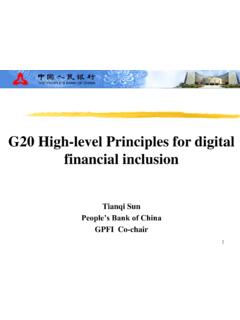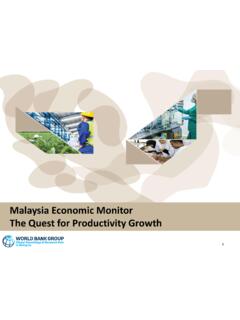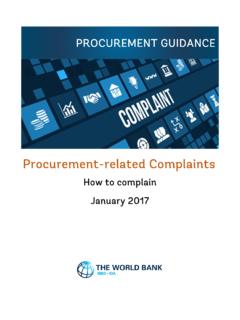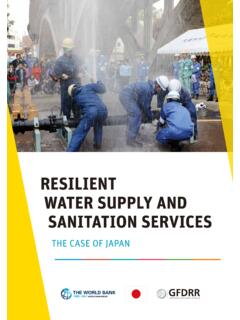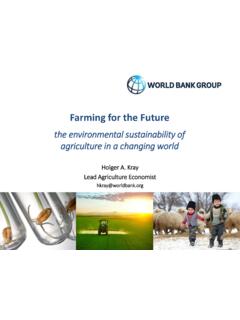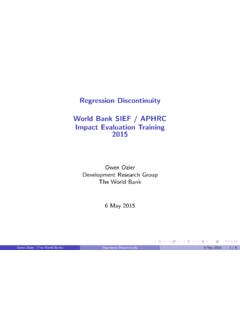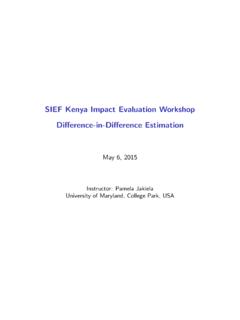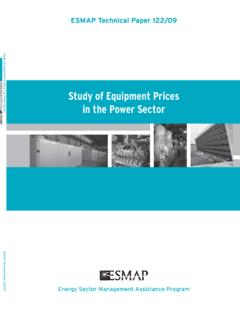Transcription of CONCENTRATING SOLAR POWER
1 CONCENTRATING SOLAR POWERCLEAN POWER ON DEMAND 24/7 CONCENTRATING SOLAR POWER : CLEAN POWER ON DEMAND 24/72 2020 International Bank for Reconstruction and Development / The World Bank 1818 H Street NW | Washington DC 20433 | USA202-473-1000 | This work is a product of the staff of the World Bank with external contributions. The findings, interpretations, and conclusions expressed in this work do not necessarily reflect the views of the World Bank, its Board of Executive Directors, or the governments they represent. The World Bank does not guarantee the accuracy of the data included in this work. The boundaries, colors, denominations, and other information shown on any map in this work do not imply any judgment on the part of the World Bank concerning the legal status of any territory or the endorsement or acceptance of such boundaries Rights and Permissions The material in this work is subject to copyright.
2 Because the World Bank encourages dissemination of its knowledge, this work may be reproduced, in whole or in part, for non-commercial purposes as long as full attribution to this work is given. Any queries on rights and licenses, including subsidiary rights, should be addressed to World Bank Publications, World Bank Group, 1818 H Street NW, Washington, DC 20433, USA; fax: 202-522-2625; All images remain the sole property of their source and may not be used for any purpose without written permission from the source. Attribution Please cite the work as follows:World Bank. 2021. CONCENTRATING SOLAR POWER : Clean POWER on Demand 24/7. Washington, DC: World Bank. Front Cover: MasenCONCENTRATING SOLAR POWER : CLEAN POWER ON DEMAND 24/73 CONTENTSA cknowledgements.
3 6 Acronyms and abbreviations ..7 Executive summary ..81. Why CONCENTRATING SOLAR POWER ? ..12 CSP explained ..12 The value of CSP ..132. Global market and outlook for CONCENTRATING SOLAR POWER ..20 A brief history of CSP ..20 Status of markets ..20 CSP market trends: Falling costs, increasing scale ..263. Frameworks for the deployment of CONCENTRATING SOLAR POWER ..29 Overview ..29 Types of support mechanisms ..29 Support mechanisms in practice ..31 Financing CSP projects ..34 References ..37 Annex A. Further reflections on CONCENTRATING SOLAR POWER technology .. SOLAR resources .. SOLAR heat generation and utilization .. Types of CSP POWER plants .. Summary of CSP plant technologies .. Thermal energy storage .. Technical challenges and trends to overcome them.
4 POWER block .. Heat transfer fluid .. Mirrors .. Frames, supports, and trackers .. Receiver .. Thermal storage system .. Hybrid systems ..54 Annex B. Development phases, component suppliers, and service providers involved in CSP projects ..57 Annex C. CSP Plants in Operation and Under Construction ..64 CONCENTRATING SOLAR POWER : CLEAN POWER ON DEMAND 24/74 LIST OF FIGURESF igure World map of direct normal irradiation (DNI) ..8 Figure Global weighted average LCOE and auction/PPA prices for CSP, onshore and offshore wind, and SOLAR ..9 Figure Key benefits of CSP technology ..10 Figure Four types of CONCENTRATING SOLAR POWER technologies ..12 Figure Parabolic trough collectors (left) and CSP tower (right) ..12 Figure World map of direct normal irradiation (DNI).
5 13 Figure Marginal curtailment in California due to overgeneration as the penetration of SOLAR photovoltaics increases ..15 Figure Peak times of daily net electricity load (after SOLAR PV): California s duck curve ..16 Figure The energy flows underpinning sustained SOLAR electricity generation throughout the day ..16 Figure Key characteristics of available energy storage technologies ..17 Figure A comparison of the levelized cost of electricity: CSP versus PV (both with nine hours of storage), 2015 30 ..17 Figure La Africana parabolic trough plant in C rdoba, Spain ..18 Figure Cumulative renewable energy capacity in Chile between January 2008 and February 2020 ..23 Figure Global weighted average LCOE and auction/PPA prices for CSP, onshore and offshore wind, and SOLAR .
6 26 Figure Global cumulative installed CSP capacity, 2006 May 2020 ..27 Figure SOLAR tower at Noor III in Ouarzazate, Morocco ..32 Figure Noor Ouarzazate SOLAR Complex ..33 Figure B How the Moroccan Agency for SOLAR Energy steered the development of CSP plants ..36 Figure SOLAR radiation components resulting from interactions with the atmosphere ..41 Figure Parabolic trough design ..42 Figure Physical principles of a parabolic trough collector ..43 Figure Parabolic trough collectors at La Africana Spain ..43 Figure Tower design ..44 Figure Components of a heliostat ..44 Figure A Linear Fresnel POWER plant ..45 Figure Two-tank direct storage system ..47 Figure Two-tank indirect storage system ..47 Figure Single-tank thermocline storage system.
7 48 Figure Steam accumulator ..48 Figure Decoupled SOLAR combined cycle system using central tower receiver ..54 Figure Schematic of CAPTure POWER plant ..55 CONCENTRATING SOLAR POWER : CLEAN POWER ON DEMAND 24/75 LIST OF TABLEST able CSP plants operating in MENA ..21 Table Pipeline of CSP projects in MENA ..21 Table CSP projects in China ..24 Table Summary of South Africa s Renewable Energy Independent POWER Producer Procurement Programme (REIPPPP) ..25 Table CSP projects in South Africa ..25 Table Incentives and support mechanisms for the commercial development of CSP, by country ..33 Table Comparison of CONCENTRATING SOLAR POWER technologies ..46 Table CONCENTRATING SOLAR POWER : Technical challenges and efforts to overcome them.
8 49 Table Material costs of thermal storage media ..54 Table Companies involved in the construction of CSP plants, by type and project phase ..57 Table CSP component suppliers and service providers ..58 Table New potential suppliers emerging from the Chinese CSP demonstration program ..63 LIST OF BOXESBox Country plans to reduce greenhouse gas emissions ..18 Box The DEWA IV 950 MW CSP/PV SOLAR hybrid project ..22 Box CSP project development and operational best practices ..28 Box CSP project structure models ..31 Box Morocco: The Noor Ouarzazate CSP Project ..36 Box Increasing generation flexibility: Thermal energy storage in decoupled SOLAR combined cycle configurations ..696 CONCENTRATING SOLAR POWER : CLEAN POWER ON DEMAND 24/7 ACKNOWLEDGEMENTSThis report provides an overview of the development of CONCENTRATING SOLAR POWER and its potential contribution in furthering cleaner and more robust energy systems in regions with high levels of direct normal irradiation (DNI).
9 This work has been carried out under the Middle East and North Africa CONCENTRATING SOLAR POWER Knowledge and Innovation Program (MENA CSP KIP) with funding from the Clean Technology Fund of the Climate Investment Funds. Preparation of this report was managed by a World Bank team led by Jonathan Edwards Sinton and Elena Cuadros. An early draft of this report was prepared by Jorge Servert, Jos Manuel Nieto and Diego L pez of SOLAR Technical Advisors (STA). This report was thoroughly reviewed by a panel of experts, chaired by Erik Fernstrom (World Bank) and which included Pierre Audinet (World Bank), Luis Crespo (European SOLAR Thermal Electricity Association), C dric Philibert (then at the International Energy Agency) and Dana Younger (then at IFC). In response to the feedback of this panel, a new draft was produced in collaboration with Pablo Ralon (IRENA) and Michael Taylor (IRENA).
10 World Bank Group staff and consultants contributed in numerous ways, and included: Zuzana Dobrotkov , Gabriela Elizondo Azuela, Therese Fernlund, Chris Edward Jackson, Vanessa Janik, Elisabeth Maier, Angeline Mani, Manuel Millan Sanchez, Deger Saygin, Yanqin Song, Nadia Taobane, Efstratios Tavoulareas, Dana Younger, Alexis Gazzo, Christoph Kost, Silvia Pariente-David, Jonathan Walters and Frank final report was reviewed, updated and edited by Carlos M rquez (ATA Insights). Alejandro Bar n (ATA Renewables) provided feedback on technical aspects of the report. Xavier Lara (AELIUSEC), Andrea Lovato (ACWA) and Mark Mehos (NREL) provided feedback on specific sections of the report. Faye Makeig proof-read and copy-edited the final report, augmenting work on an earlier version by Steven Kennedy.

